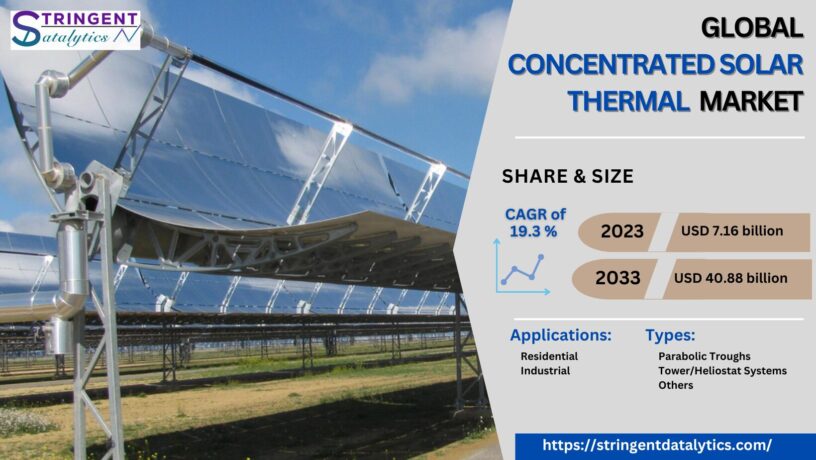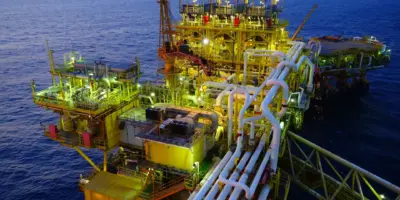The global Concentrated Solar Thermal Market size was valued at USD 7.16 billion in 2023 and is expected to surpass around USD 40.88 billion by 2033, poised to grow at a CAGR of 19.3% during the forecast period 2024 to 2033.
Introduction
The Concentrated Solar Thermal (CST) market involves technologies that concentrate sunlight to produce thermal energy, which can then be used to generate electricity or provide heat for industrial processes. CST systems use mirrors or lenses to focus a large area of sunlight onto a small area, converting solar energy into high-temperature heat. This heat is then used to produce steam that drives a turbine connected to an electricity generator. This market overview will explore the components, types, applications, key players, market dynamics, challenges, and future trends of the CST market.
Components of Concentrated Solar Thermal Systems
Solar Collectors
Solar collectors are critical in CST systems, capturing and concentrating solar energy. There are various types, including parabolic troughs, solar power towers, linear Fresnel reflectors, and dish Stirling systems.
- Parabolic Troughs: These use parabolic mirrors to focus sunlight onto a receiver tube along the focal line.
- Solar Power Towers: Use a field of flat, movable mirrors (heliostats) to focus sunlight on a central receiver at the top of a tower.
- Linear Fresnel Reflectors: Utilize long, flat mirrors to focus sunlight onto a fixed receiver.
- Dish Stirling Systems: Use a parabolic dish to concentrate sunlight onto a receiver mounted at the dish’s focal point.
Receivers
Receivers absorb the concentrated sunlight and convert it into heat. This heat is transferred to a working fluid, typically oil, molten salt, or water, which transports the thermal energy.
Heat Transfer Fluids (HTFs)
HTFs are used to carry thermal energy from the receiver to the heat exchanger or storage system. Common HTFs include synthetic oil, molten salts, and pressurized steam.
Heat Exchangers
Heat exchangers transfer thermal energy from the HTF to water or another working fluid to produce steam, which drives turbines to generate electricity.
Thermal Energy Storage Systems
Thermal energy storage (TES) systems store excess thermal energy for use during periods without sunlight, such as nighttime or cloudy days. Common storage mediums include molten salt and phase-change materials.
Power Blocks
The power block consists of steam turbines and generators that convert thermal energy into electricity.
Types of Concentrated Solar Thermal Systems
Parabolic Trough Systems
Parabolic trough systems are the most mature CST technology. They use parabolic mirrors to focus sunlight onto a receiver tube containing HTF, which then generates steam to drive a turbine.
Solar Power Towers
Solar power towers use a field of heliostats to concentrate sunlight onto a central receiver. The high temperatures achieved allow for efficient electricity generation and thermal storage.
Linear Fresnel Reflectors
Linear Fresnel reflectors are similar to parabolic troughs but use flat mirrors to focus sunlight onto a stationary receiver. They are less expensive but less efficient than parabolic troughs.
Dish Stirling Systems
Dish Stirling systems use a parabolic dish to concentrate sunlight onto a Stirling engine or another type of receiver. They are highly efficient but more suitable for small-scale applications.
Applications of Concentrated Solar Thermal Systems
Electricity Generation
The primary application of CST systems is large-scale electricity generation. CST plants can provide reliable power when integrated with TES systems, making them suitable for baseload and peak load power generation.
Industrial Process Heat
CST systems can provide high-temperature heat for various industrial processes, such as chemical production, metal processing, and food and beverage manufacturing.
Desalination
CST technology can be used in desalination plants to produce freshwater from seawater. The thermal energy from CST systems drives the desalination process, reducing reliance on fossil fuels.
Enhanced Oil Recovery
CST systems can be used to generate steam for enhanced oil recovery (EOR) processes, improving the efficiency and sustainability of oil extraction.
District Heating
CST systems can supply heat to district heating networks, providing a sustainable and efficient way to heat buildings in urban areas.
Market Dynamics
Drivers
Increasing Demand for Renewable Energy
The global push for renewable energy sources to reduce greenhouse gas emissions and combat climate change is a significant driver for the CST market. Governments and organizations are investing in CST technologies to diversify their energy portfolios and reduce reliance on fossil fuels.
Technological Advancements
Advancements in CST technology, including improved collector designs, more efficient receivers, and better thermal storage systems, are enhancing the efficiency and cost-effectiveness of CST plants. These innovations are driving market growth and making CST more competitive with other renewable energy sources.
Energy Security
CST technology can enhance energy security by providing a reliable and sustainable energy source. Countries with high solar insolation can leverage CST to reduce their dependence on imported fossil fuels and increase energy independence.
Restraints
High Initial Investment
The construction of CST plants requires significant capital investment, including the cost of materials, land, and labor. This high initial investment can be a barrier to market growth, particularly in regions with limited financial resources.
Land and Water Requirements
CST plants require large areas of land for solar collectors and substantial amounts of water for cooling and steam generation. These requirements can be challenging in densely populated or water-scarce regions.
Opportunities
Emerging Markets
Emerging markets, particularly in regions with high solar insolation, present significant growth opportunities for the CST market. These regions can benefit from the sustainable energy and economic development that CST offers.
Hybrid Systems
Integrating CST with other renewable energy sources, such as photovoltaic (PV) panels or wind turbines, can enhance overall energy production and reliability. Hybrid systems that combine multiple renewable sources can provide more consistent and reliable power generation.
Challenges
Competition from Other Renewable Sources
CST competes with other renewable energy sources, such as solar PV and wind energy. These technologies are well-established and often more familiar to investors, posing a challenge for the adoption of CST.
Technical Challenges
CST systems face technical challenges, including optimizing the efficiency of solar collectors, improving thermal storage systems, and reducing water usage. Addressing these challenges requires ongoing research and development.
Receive the FREE Sample Report of Concentrated Solar Thermal Market Research Insights @ https://stringentdatalytics.com/sample-request/concentrated-solar-thermal-market/15274/
Market Segmentations:
Global Concentrated Solar Thermal Market: By Company
Abengoa
Acciona
Orano
BrightSource Energy
Directed Vapor
GE Energy
Hitachi
SCHOTT
SEIA
Siemens
Global Concentrated Solar Thermal Market: By Type
Parabolic Troughs
Tower/Heliostat Systems
Others
Global Concentrated Solar Thermal Market: By Application
Residential
Industrial
Regional Analysis of Global Concentrated Solar Thermal Market
All the regional segmentation has been studied based on recent and future trends, and the market is forecasted throughout the prediction period. The countries covered in the regional analysis of the Global Concentrated Solar Thermal market report are U.S., Canada, and Mexico in North America, Germany, France, U.K., Russia, Italy, Spain, Turkey, Netherlands, Switzerland, Belgium, and Rest of Europe in Europe, Singapore, Malaysia, Australia, Thailand, Indonesia, Philippines, China, Japan, India, South Korea, Rest of Asia-Pacific (APAC) in the Asia-Pacific (APAC), Saudi Arabia, U.A.E, South Africa, Egypt, Israel, Rest of Middle East and Africa (MEA) as a part of Middle East and Africa (MEA), and Argentina, Brazil, and Rest of South America as part of South America.
Click to Purchase Concentrated Solar Thermal Market Research Report @ https://stringentdatalytics.com/purchase/concentrated-solar-thermal-market/15274/?license=single
Market Trends
Integration with Energy Storage
Integrating CST systems with advanced energy storage solutions, such as molten salt storage, enhances their reliability and efficiency. These storage systems allow CST plants to provide power even during periods without sunlight, making them suitable for baseload power generation.
Policy Support and Incentives
Supportive government policies and incentives are crucial for the growth of the CST market. Tax credits, grants, and subsidies can reduce the financial barriers to adopting CST technology and encourage investment in renewable energy projects.
Development of Small-Scale CST Systems
While large-scale CST plants are the most common, there is growing interest in developing small-scale systems for specific applications, such as residential or community use. These smaller systems can provide localized energy solutions and expand the market reach of CST technology.
Focus on Sustainability
The increasing focus on sustainability and environmental protection is driving the adoption of CST systems. These systems offer a clean energy solution with minimal environmental impact, making them an attractive option for sustainable development initiatives.
Future Prospects
Expansion in Emerging Markets
Emerging markets, particularly in regions with high solar insolation, are expected to be key growth areas for the CST market. These regions can benefit from the sustainable energy and economic development that CST offers.
Advances in Material Science
Advances in material science, such as the development of new heat-resistant and lightweight materials, can improve the efficiency and cost-effectiveness of CST systems. These innovations can make CST more competitive with other renewable energy sources.
Enhanced Collector Design
Improving the design and efficiency of solar collectors used in CST systems can increase the overall performance of these systems. Innovations in mirror and lens technology, as well as receiver designs, are expected to drive future market growth.
Integration with Smart Grids
Integrating CST systems with smart grid technology can enhance the management and distribution of the generated energy. Smart grids can optimize energy use, reduce waste, and improve the reliability of power supply from CST plants.
About Stringent Datalytics
Stringent Datalytics offers both custom and syndicated market research reports. Custom market research reports are tailored to a specific client’s needs and requirements. These reports provide unique insights into a particular industry or market segment and can help businesses make informed decisions about their strategies and operations.
Syndicated market research reports, on the other hand, are pre-existing reports that are available for purchase by multiple clients. These reports are often produced on a regular basis, such as annually or quarterly, and cover a broad range of industries and market segments. Syndicated reports provide clients with insights into industry trends, market sizes, and competitive landscapes. By offering both custom and syndicated reports, Stringent Datalytics can provide clients with a range of market research solutions that can be customized to their specific needs.
Reach US
Stringent Datalytics
+1 346 666 6655
Social Channels:




Leave a Reply